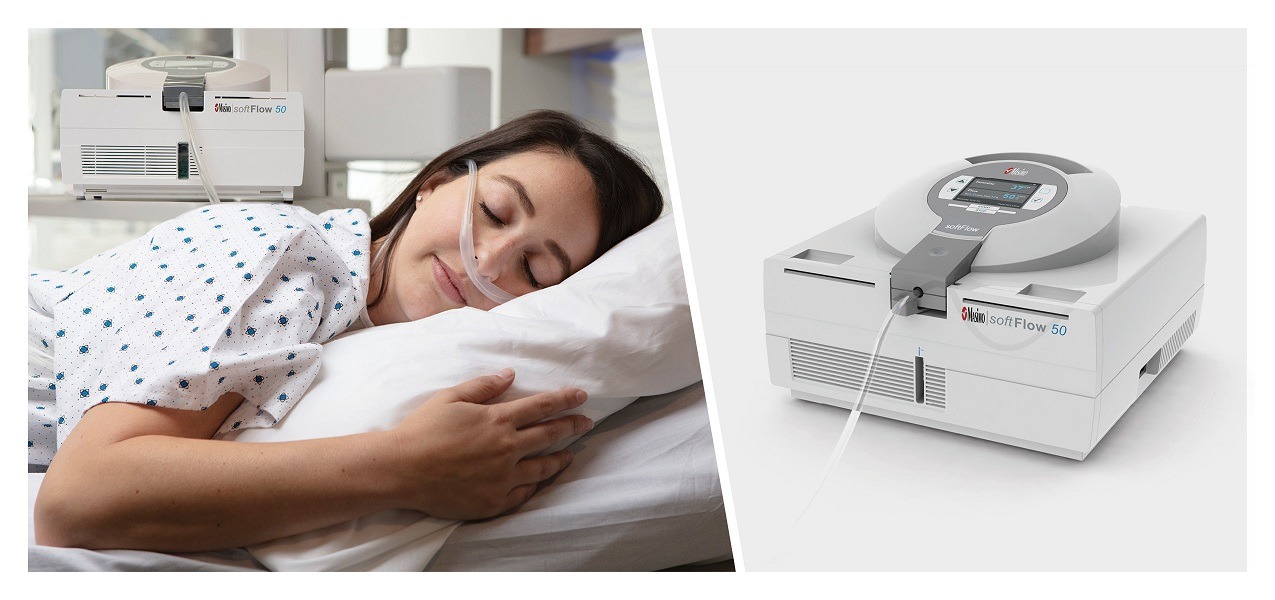
Masimo (NASDAQ: MASI) today announced the U.S. introduction of softFlow®, innovative pulmonary care therapy which provides nasal high-flow warmed and humidified respiratory gases to spontaneously breathing patients. The technology, available on the softFlow 50, offers adult patients high-flow respiratory support through a soft nasal cannula by generating a consistent high flow of warm, humidified air or air/oxygen mixture.
As the COVID-19 pandemic continues, increasing the number of patients suffering from respiratory conditions and requiring respiratory support, softFlow offers clinicians across the continuum of care an important tool to help in the treatment of spontaneously breathing patients. Capable of operating without an external compressed air supply, softFlow is designed for maximum versatility, with utility in settings throughout the hospital, long term-care facilities, and use at home. To reduce the risk of cross-contamination, softFlow uses a single-patient-use flow path from the internal mixing chamber to the patient and a bacterial/viral filter designed to filter contaminants from the air delivered to the patient.
The U.S. National Institutes of Health (NIH) and World Health Organization (WHO) have both suggested that the use of High-Flow Nasal Cannula (HFNC) therapy, like softFlow, is a viable option for providing respiratory support for select COVID-19 patients for whom conventional oxygen therapy may be insufficient.1 softFlow can provide patients suffering from COVID-19 or other respiratory conditions with higher flow rates of oxygen than conventional oxygen therapies. As a therapy, NIH concluded, “HFNC is preferred over Noninvasive Positive Pressure Ventilation (NIPPV) in patients with acute hypoxemic respiratory failure based on data from an unblinded clinical trial in patients without COVID-19 who had acute hypoxemic respiratory failure.”2 The referenced study found a higher number of ventilator-free days (24 days) with HFNC than with conventional oxygen therapy (22 days) or NIPPV (19 days) (p=0.02). The researchers also found a lower 90-day mortality rate compared to conventional oxygen therapy or NIPPV.3
With softFlow, the airflow is consistently delivered through the nose, allowing patients to continue to eat, drink, and speak, which is difficult with mask-based forms of respiratory support. In addition, the softFlow 50 system provides warm, humidified gas into the patient’s nose, to enhance comfort and aid in mucous clearance.4,5 With its ability to precisely deliver high respiratory gas flow rates well above those required for typical respiratory demand, clinicians can also take advantage of the high-flow rate to help limit the entrainment of room air (which can reduce the quantity of delivered inhaled oxygen).
The innovative integrated airflow generator of the softFlow technology and water reservoir attachment allow for continued HFNC treatment of recovering COVID-19 patients in the home and other care settings, without the need for a separate source for high-flow air like other devices. The device’s simple, intuitive interface allows patients or their caregivers (who can lock settings) to easily customize the flow rate and humidification level.
First available in 2016, softFlow is now in use in numerous countries in Africa, Asia, and Europe.
Beijing Aerospace Changfeng Co., LTD, of China, noted, “We are very satisfied with the therapy successes we achieve with this device. We would like to emphasize the stable flow during inhalation and exhalation, which is generated by the powerful motor, which doesn’t need an external air source, as well as the resulting CO2 washing out. This fact opens up possibilities for [use as] a therapy for hypercapnic patients. Another very positive aspect of the device is the way it prevents condensation in the applicator by warming the entire tube system up to the nasal cannula. … All in all we are very satisfied with the handling of the device and the medical results.”
Miguel Marina Barrio, Product Manager, Intensive Care Division, Hospital Hispania, Spain, added, “We already ordered 50 devices and we are very satisfied with the way softFlow performed. … In our opinion, the following points are very good: menu structure, product features, design, usability, manuals, delivery times. … The product quality, customer service, and type of packaging are particularly excellent.”
Dr. Dalal Al Matrouk, Head of Anesthesia and ICU at Farwaniya Hospital, Ministry of Health, Kuwait, said, “We have deployed 10 units of Masimo softFlow to help our clinicians manage patients with COVID-19-induced respiratory problems. We realize that high-flow nasal therapy could potentially help avoid invasive mechanical ventilation and its associated risks of ventilator-induced lung injury and hospital-acquired pneumonia.”
Joe Kiani, Founder and CEO of Masimo, said, “We believe softFlow provides clinicians with an important tool to help address the growing number of people with compromised respiratory function, whether in high-acuity or low-acuity settings, including at home. We’re happy to now be able to offer this technology in the United States.”
The softFlow 50 is FDA cleared for use in hospital and long-term care facilities. Home use is being made available in the US under the FDA Enforcement Policy for Ventilators and Accessories and Other Respiratory Devices During the COVID-19 Public Health Emergency.
Source: Company Press Release



